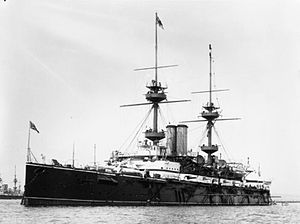
HMS Ocean was a pre-dreadnought battleship of the British Royal Navy and a member of the Canopus class. Intended for service in Asia, Ocean and her sister ships were smaller and faster than the preceding Majestic-class battleships, but retained the same battery of four 12-inch (305 mm) guns. She also carried thinner armour, but incorporated new Krupp steel, which was more effective than the Harvey armour used in the Majestics. Ocean was laid down in December 1897, launched in July 1898, and commissioned into the fleet in February 1900.
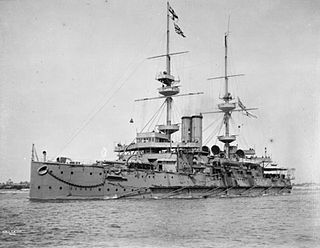
HMS Caesar was a Majestic-class pre-dreadnought battleship of the Royal Navy, named after the Roman military and political leader Julius Caesar. The ship was built at the Portsmouth Dockyard, starting with her keel laying in March 1895. She was launched in September 1896 and was commissioned into the fleet in January 1898. She was armed with a main battery of four 12-inch (305 mm) guns and a secondary battery of twelve 6-inch (152 mm) guns. The ship had a top speed of 16 knots.
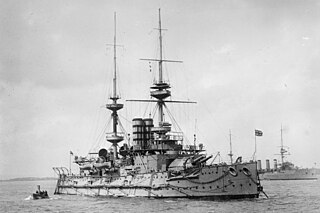
The Majestic class of nine pre-dreadnought battleships were built for the Royal Navy in the mid-1890s under the Spencer Programme, named after the First Lord of the Admiralty, John Poyntz Spencer. With nine units commissioned, they were the most numerous class of battleships. The nine ships, HMS Majestic, Caesar, Hannibal, Illustrious, Jupiter, Magnificent, Mars, Prince George, and Victorious, were built between 1894 and 1898 as part of a programme to strengthen the Royal Navy versus its two traditional rivals, France and Russia. This continued the naval re-armament initiatives begun by the Naval Defence Act 1889.
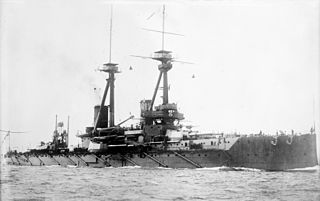
HMS Bellerophon was the lead ship of her class of three dreadnought battleships built for the Royal Navy in the first decade of the 20th century. She spent her whole career assigned to the Home and Grand Fleets. Aside from participating in the Battle of Jutland in May 1916 and the inconclusive action of 19 August, her service during the First World War generally consisted of routine patrols and training in the North Sea. The ship was deemed obsolete after the war and was used as a training ship before she was placed in reserve. Bellerophon was sold for scrap in 1921 and broken up beginning the following year.

HMS Irresistible—the fourth British Royal Navy ship of the name—was a Formidable-class pre-dreadnought battleship. The Formidable-class ships were developments of earlier British battleships, featuring the same battery of four 12-inch (305 mm) guns—albeit more powerful 40-calibre versions—and top speed of 19 knots of the preceding Canopus class, while adopting heavier armour protection. The ship was laid down in April 1898, was launched in December that year, and was completed in October 1901. Commissioned in 1902, she initially served with the Mediterranean Fleet until April 1908, when she was transferred to the Channel Fleet. Now outclassed with the emergence of the dreadnought class of ships, she entered service with the Home Fleet in 1911 following a refit. In 1912, she was assigned to the 5th Battle Squadron.

HMS Majestic was a Majestic-class pre-dreadnought battleship of the Royal Navy. Commissioned in 1895, she was the largest pre-dreadnought launched at the time. She served with the Channel Fleet until 1904, following which she was assigned to the Atlantic Fleet. In 1907, she was part of the Home Fleet, firstly assigned to the Nore Division and then with the Devonport Division. From 1912, she was part of the 7th Battle Squadron.
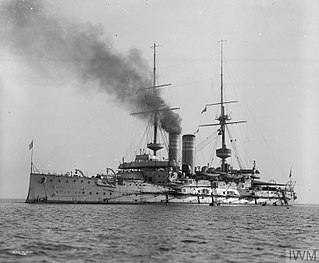
HMS Albion was a pre-dreadnought battleship of the British Royal Navy and a member of the Canopus class. Intended for service in Asia, Albion and her sister ships were smaller and faster than the preceding Majestic-class battleships, but retained the same battery of four 12-inch (305 mm) guns. She also carried thinner armour, but incorporated new Krupp steel, which was more effective than the Harvey armour used in the Majestics. Albion was laid down in December 1896, launched in June 1898, and commissioned into the fleet in June 1901.

HMS Victorious was one of nine Majestic-class pre-dreadnought battleships of the British Royal Navy. She was armed with a main battery of four 12-inch (305 mm) guns in two twin turrets, and was capable of a top speed of 16 knots. She served primarily on home waters, and participated in the Fleet Review for the Diamond Jubilee for Queen Victoria in 1897. She served briefly in the Mediterranean in 1898 before being transferred to the China Station later that year; Victorious remained in East Asian waters until 1900, when she returned to the Mediterranean.

HMS Albemarle was a pre-dreadnought Duncan-class battleship of the Royal Navy, named after George Monck, 1st Duke of Albemarle. Built to counter a group of fast Russian battleships, Albemarle and her sister ships were capable of steaming at 19 knots, making them the fastest battleships in the world. The Duncan-class battleships were armed with a main battery of four 12-inch (305 mm) guns and they were broadly similar to the London-class battleships, though of a slightly reduced displacement and thinner armour layout. As such, they reflected a development of the lighter second-class ships of the Canopus-class battleship. Albemarle was built between her keel laying in January 1900 and her completion in November 1903.

HMS Bulwark was one of five London-class pre-dreadnought battleships built for the Royal Navy at the end of the 19th century. The Londons were a sub-class of the Formidable-class pre-dreadnoughts. Completed in 1902 she was initially assigned to the Mediterranean Fleet as its flagship. The ship then served with the Channel and Home Fleets from 1907 to 1910, usually as a flagship. From 1910 to 1914, she was in reserve in the Home Fleet.
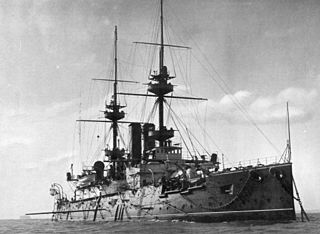
HMS Jupiter was a Majestic-class pre-dreadnought battleship of the Royal Navy. Commissioned in 1897, she was assigned to the Channel Fleet until 1905. After a refit, she was temporarily put in reserve before returning to service with the Channel Fleet in September 1905. In 1908 and rendered obsolete by the emergence of the dreadnought type of battleships, she once again returned to the reserve, this time with the Home Fleet. After another refit, she had a spell as a gunnery training ship in 1912.
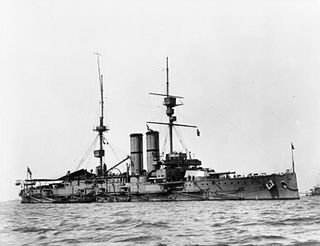
HMS Hibernia was a King Edward VII-class pre-dreadnought battleship of Britain's Royal Navy. Like all ships of the class she was named after an important part of the British Empire, namely Ireland. The ship was built by Devonport Dockyard; she was laid down in January 1904, was launched in June 1905, and was completed in December 1906. Armed with a battery of four 12-inch (305 mm) and four 9.2 in (234 mm) guns, she and her sister ships marked a significant advance in offensive power compared to earlier British battleship designs that did not carry the 9.2 in guns.
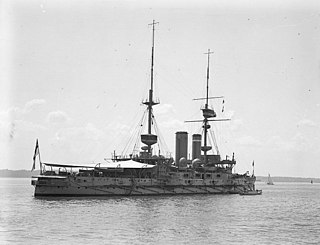
HMS Implacable was a Formidable-class battleship of the British Royal Navy, the second ship of the name. The Formidable-class ships were developments of earlier British battleships, featuring the same battery of four 12-inch (305 mm) guns—albeit more powerful 40-calibre versions—and top speed of 19 knots of the preceding Canopus class, while adopting heavier armour protection. The ship was laid down in July 1898, was launched in March 1899, and was completed in July 1901. Commissioned in September 1901, she was assigned to the Mediterranean Fleet and served with the fleet until 1908. After a refit, she transferred to the Channel Fleet, then onto the Atlantic Fleet in May 1909. By now rendered obsolete by the emergence of the dreadnought class ships, she was assigned to the 5th Battle Squadron and attached to the Home Fleet in 1912.

HMS London was the lead ship of the London class of pre-dreadnought battleships built for the British Royal Navy. The Londons were near repeats of the preceding Formidable-class battleships, but with modified armour protection. The ship was laid down in December 1898, was launched in September 1899, and was completed in June 1902. Commissioned the same month, she served with the Mediterranean Fleet until early 1907. She was assigned to the Nore Division of the Home Fleet for nearly a year before transferring to the Channel Fleet. Rendered obsolete with the emergence of the new dreadnoughts in late 1906, she underwent an extensive refit in 1909, after which she served with the Atlantic Fleet. She was assigned to the Second Home Fleet in 1912 as part of the 5th Battle Squadron, and was temporarily fitted with a makeshift ramp for experiments with naval aircraft until 1913.

HMS Hannibal was a Majestic-class pre-dreadnought battleship built for the Royal Navy, and the sixth ship to bear the name HMS Hannibal. The ship was laid down at the Pembroke Dock in May 1894, she was launched in April 1896, and commissioned into the fleet in April 1898. She was armed with a main battery of four 12-inch (305 mm) guns and a secondary battery of twelve 6-inch (152 mm) guns. The ship had a top speed of 16 knots.

HMS Prince George was a Majestic-class pre-dreadnought battleship launched in 1895. She was named after the future George V of the United Kingdom and was the fourth and final ship to bear that name. Commissioned in 1896, she initially served with the Channel Fleet until 1904. She was involved in a collision with her sister ship, Hannibal, and the resulting damage meant that much of the latter part of 1903 was spent being repaired. After a refit in 1904, she was assigned to the Atlantic Fleet and then from 1907, she was part of the Home Fleet. In 1912, she was assigned to the 7th Battle Squadron.

HMS Mars was a Royal Navy pre-dreadnought battleship of the Majestic class, the seventh member of a class of nine ships. The ship was laid down in the Laird Brothers shipyard in June 1894, she was launched in March 1896, and she was commissioned into the fleet in June 1897. She was armed with a main battery of four 12-inch (305 mm) guns and a secondary battery of twelve 6-inch (152 mm) guns. The ship had a top speed of 16 knots.

HMS Glory was a pre-dreadnought battleship of the British Royal Navy and a member of the Canopus class. Intended for service in Asia, Glory and her sister ships were smaller and faster than the preceding Majestic-class battleships, but retained the same battery of four 12-inch (305 mm) guns. She also carried thinner armour, but incorporated new Krupp steel, which was more effective than the Harvey armour used in the Majestics. Glory was laid down in December 1896, launched in March 1899, and commissioned into the fleet in November 1900.
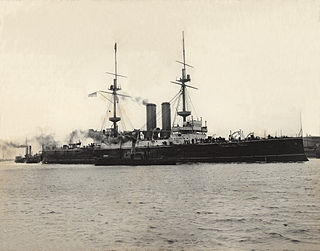
HMS Vengeance was a pre-dreadnought battleship of the British Royal Navy and a member of the Canopus class. Intended for service in Asia, Vengeance and her sister ships were smaller and faster than the preceding Majestic-class battleships, but retained the same battery of four 12-inch (305 mm) guns. She also carried thinner armour, but incorporated new Krupp steel, which was more effective than the Harvey armour used in the Majestics. Vengeance was laid down in August 1898, launched in July 1899, and commissioned into the fleet in April 1902.

HMS Exmouth was a Duncan-class pre-dreadnought battleship of the Royal Navy. Built to counter a group of fast Russian battleships, Exmouth and her sister ships were capable of steaming at 19 knots, making them the fastest battleships in the world. The Duncan-class battleships were armed with a main battery of four 12-inch (305 mm) guns and they were broadly similar to the London-class battleships, though of a slightly reduced displacement and thinner armour layout. As such, they reflected a development of the lighter second-class ships of the Canopus-class battleship. Exmouth was laid down by Laird Brothers at Birkenhead in August 1899, launched in August 1901, and completed in May 1903.
